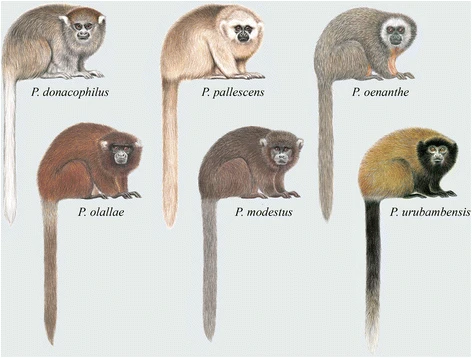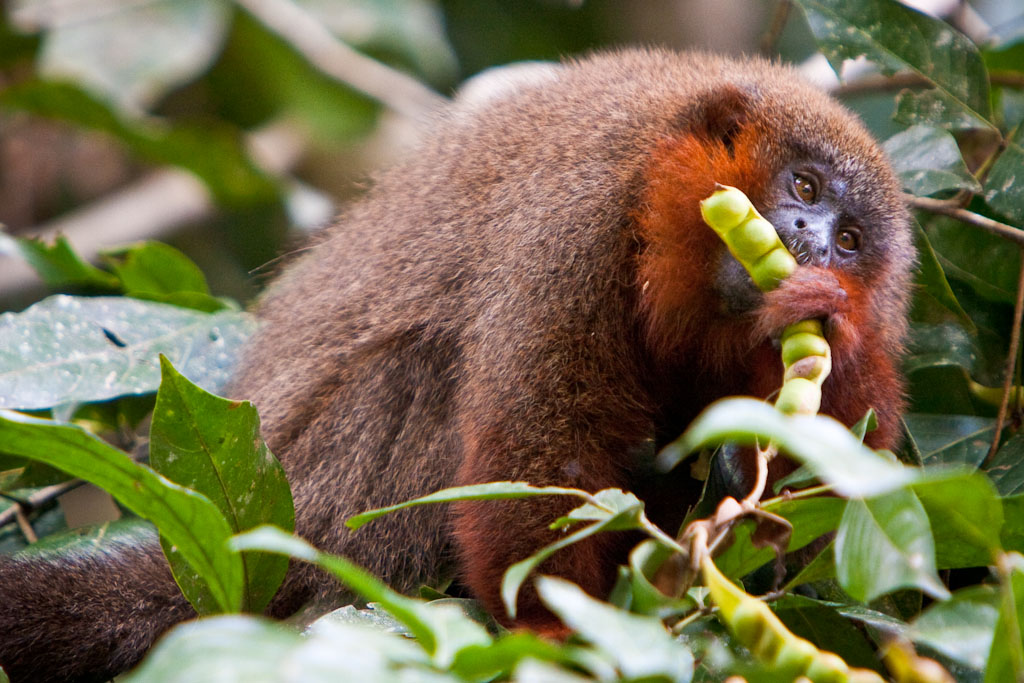|
Plecturocebus Moloch Group
''Plecturocebus'' is one of three genera of titi monkeys. Historically, these monkeys were monogeneric, being placed in a single genus: ''Callicebus'' Thomas, 1903. Owing to the great diversity found across titi monkey species, a new genus-level taxonomy was proposed in 2016 that recognises three genera within the subfamily Callicebinae; ''Plecturocebus'' Byrne et al., 2016 for the Amazonian and Chaco titis of the ''moloch'' and ''donacophilus'' groups; ''Cheracebus ''Cheracebus'' is one of three genera of titi monkeys. Monkeys in this genus, particularly the type species '' Cheracebus lugens'', are sometimes referred to as widow titi monkeys. Historically, titis were monogeneric, comprising only the genus ...'' Byrne et al., 2016 for the species of the ''torquatus'' group (Widow titis); and ''Callicebus'' Thomas, 1903 ''sensu stricto'', for species of the Atlantic Forest ''personatus'' group. ''Plecturocebus'' is derived from the Latin forms of three Greek words: plektos ... [...More Info...] [...Related Items...] OR: [Wikipedia] [Google] [Baidu] |
Brown Titi
The brown titi monkey (''Plecturocebus brunneus'') is a species of titi monkey, a type of New World monkey, from South America. It is endemic to Brazil. It was originally described as ''Callicebus brunneus'' in 1842 and transferred to the newly erected genus ''Plecturocebus'' in 2016. Taxonomy ''Plecturocebus'' are within a subfamily of titi called Callicebinae. Other genera included within this subfamily are the ''Cheracebus'', ''Callicebus'', and ''Plecturocebus;'' which are all still currently extant. The '' Xenothrix, Antillothrix'', ''Paralouatta, Carlocebus, Lagonimico'', and '' Tremacebus'' genera of Callicebinae are extinct. The Urubamba brown titi (''P. urubambensis'') of Peru was formerly thought to be a Peruvian population of ''P. brunneus'', but a 2015 study found it to be a distinct, undescribed species more closely related to the white-eared titi (''P. donacophilus''), and described it as such. The Brown Titi was classified as its own genus in 2016. Due to the p ... [...More Info...] [...Related Items...] OR: [Wikipedia] [Google] [Baidu] |
Baptista Lake Titi Monkey
The Baptista Lake titi monkey (''Plecturocebus baptista'') is a species of titi monkey, a type of New World monkey, endemic to Brazil. It was originally described as ''Callicebus baptista'' in 1939. References Baptista Lake titi Mammals of Brazil Endemic fauna of Brazil Baptista Lake titi The Baptista Lake titi monkey (''Plecturocebus baptista'') is a species of titi monkey, a type of New World monkey, Endemic (ecology), endemic to Brazil. It was originally described as ''Callicebus baptista'' in 1939. References Plectur ... Taxa named by Einar Lönnberg {{newworld-monkey-stub ... [...More Info...] [...Related Items...] OR: [Wikipedia] [Google] [Baidu] |
Ornate Titi Monkey
The ornate titi monkey (''Plecturocebus ornatus'') is a species of titi monkey and is the smallest member of the family Pitheciidae, which also includes uakaris and saki monkeys. As it is a member of this family, it is classified as a type of New World monkey. It is endemic to eastern Colombia, and the only member of the ''Plecturocebus moloch'' group to occur north of the Rios Amazonas/Solimes/Napo axis, living at least 350 km away from the closest other member, the white-tailed titi (''Plecturocebus discolor''), which lives in the south of Colombia. It was once classified as the same species as the white-tailed titi, but is now officially recognized as its own species. The ornate titi is also terrestrial. The ornate titi is present on the IUCN Red List of endangered species, being recognized as “Vulnerable”, and having a general decrease in population trends. Description The ornate titi has a thick, dense, fluffy, coat, with white ears and forehead, and grey hands an ... [...More Info...] [...Related Items...] OR: [Wikipedia] [Google] [Baidu] |
Red-bellied Titi Monkey
The red-bellied titi monkey or dusky titi (''Plecturocebus moloch'') is a species of titi monkey, a type of New World monkey, endemic to Brazil. It lives in forests and thickets. It has a rounded head and a thick, soft coat and frequently adopts a characteristic posture with the body hunched, limbs close together, and a tail hanging down. The body is long, and the tail is . It can move quite fast if necessary but rarely does so and generally stays within a fairly small area, feeding on fruit, insects, spiders, small birds, and bird's eggs. It is diurnal and moves in pairs or family groups, which communicate by means of a wide repertoire of sounds. The female gives birth to a single offspring. Physical description The red-bellied titi has an average head and body length of for males and for females, showing no sexual dimorphism. Its tail has a greater length than the head and body combined. Males weigh between while females range from . It has a larger pollex than its hall ... [...More Info...] [...Related Items...] OR: [Wikipedia] [Google] [Baidu] |
Milton's Titi Monkey
Milton's titi monkey (''Plecturocebus miltoni'') is a species of titi monkey, a type of New World monkey, from southern Amazon rainforest, Brazil. It was named after the Brazilian primatologist Milton Thiago de Mello. Milton's titi was discovered in 2011 by Julio César Dalponte, and recognized as a new species in 2014. Appearance Milton's titi has a light gray band on its forehead, dark ochre sideburns and throat, a dark grey torso and flanks, a uniformly orange tail, and a light ochre abdomen. Distribution and natural history ''Plecturocebus miltoni'' was discovered in the state of Mato Grosso and the state of Amazonas, Brazil. The geographic distribution is centered around the Aripuanã River, Roosevelt River and Guariba River. The holotype of the species was retrieved along the right bank of the Roosevelt River, at the Guariba-Roosevelt Extractive Reserve (08°59'45.21"S 60°43'42.72" W). The habitat distribution is considered to be the interfluvial region between th ... [...More Info...] [...Related Items...] OR: [Wikipedia] [Google] [Baidu] |
Hoffmanns's Titi Monkey
Hoffmanns's titi monkey (''Plecturocebus hoffmannsi'') is a species of titi monkey, a type of New World monkey, endemic to Brazil Brazil ( pt, Brasil; ), officially the Federative Republic of Brazil (Portuguese: ), is the largest country in both South America and Latin America. At and with over 217 million people, Brazil is the world's fifth-largest country by area .... It was described as ''Callicebus hoffmannsi'' in 1908. References Hoffmanns's titi Mammals of Brazil Endemic fauna of Brazil Hoffmanns's titi Hoffmanns's titi {{newworld-monkey-stub ... [...More Info...] [...Related Items...] OR: [Wikipedia] [Google] [Baidu] |
Alta Floresta Titi Monkey
The Alta Floresta titi monkey (''Plecturocebus grovesi''), also known as the Groves' titi monkey, is a species of titi monkey, a type of New World monkey, endemic to Brazil. It was described from the municipality of Alta Floresta in the state of Mato Grosso. It is a member of the Eastern Amazonian clade of the red-bellied titi monkey (''P. moloch'') group, and is the sister taxon to the clade containing the red-bellied titi and Vieira's titi monkey (''P. vieirai''). It can be distinguished from other species in the ''P. moloch'' group by the combination of its agouti dorsal parts, the bright red-brown venter, the entirely black tail with a white tip, and the light yellow fur on the cheeks. This species is projected to lose up to 86% of its forest habitat under a typical deforestation rate, and is thus classified as Critically Endangered under the IUCN Red List The International Union for Conservation of Nature (IUCN) Red List of Threatened Species, also known as the IUCN R ... [...More Info...] [...Related Items...] OR: [Wikipedia] [Google] [Baidu] |
Hershkovitz's Titi Monkey
Hershkovitz's titi monkey (''Plecturocebus dubius'') is a species of titi monkey, a type of New World monkey, from South America. It is found in Bolivia, Brazil, and Peru. The common name is in reference to American zoologist Philip Hershkovitz, who described the species as ''Callicebus dubius'' in 1988. References Hershkovitz's titi Mammals of Brazil Mammals of Peru Mammals of Bolivia Hershkovitz's titi Hershkovitz's titi monkey (''Plecturocebus dubius'') is a species of titi monkey, a type of New World monkey, from South America. It is found in Bolivia, Brazil, and Peru. The common name is in reference to American zoologist Philip Hershkovitz, ... Taxa named by Philip Hershkovitz {{newworld-monkey-stub ... [...More Info...] [...Related Items...] OR: [Wikipedia] [Google] [Baidu] |
White-tailed Titi Monkey
The white-tailed titi monkey (''Plecturocebus discolor'') is a species of titi monkey, a type of New World monkey, from South America. It is found in Colombia, Ecuador and Peru. It was described in 1848 as ''Callithrix discolor''. References white-tailed titi Mammals of Peru Mammals of Ecuador Mammals of Colombia white-tailed titi white-tailed titi The white-tailed titi monkey (''Plecturocebus discolor'') is a species of titi monkey, a type of New World monkey, from South America. It is found in Colombia, Ecuador and Peru , image_flag = Flag of Peru.svg , image_coat ... Taxa named by Isidore Geoffroy Saint-Hilaire {{newworld-monkey-stub ... [...More Info...] [...Related Items...] OR: [Wikipedia] [Google] [Baidu] |
Coppery Titi Monkey
The coppery titi monkey (''Plecturocebus cupreus''), or red titi monkey, is a species of titi monkey, a type of New World monkey, from South America. They are found in the Amazon of Brazil and Peru, and perhaps northern Bolivia. It was described as ''Callithrix cupreus'' in 1823. These monkeys have a lifespan of a little over 20 years. These monkeys eat certain fruits, insects, and plants. They live in monogamous pairs with interesting ways for vocalizing and protecting themselves from predators. Location, habitat and activity Coppery titis typically inhabit lowland tropical and sub-tropical forests in areas that flood seasonally. They can also be found in forest understory habitats, young forests, swamp edges, and bamboo thickets. Their populations are mainly found west of the Rio Madeira in Brazil, around the Rio Huallaga in Peru, within the upper Rio Madre de Dios basin in Peru and Bolivia, near the northern Rio-Maranon-Amazonas area, around the Eastern Cordillera in Peru and ... [...More Info...] [...Related Items...] OR: [Wikipedia] [Google] [Baidu] |
Ashy Black Titi Monkey
The ashy black titi monkey (''Plecturocebus cinerascens'') is a species of titi monkey, a type of New World monkey, endemic to Brazil. It was originally described as ''Callithrix cinerascens'' in 1823. References ashy black titi Mammals of Brazil Endemic fauna of Brazil ashy black titi The ashy black titi monkey (''Plecturocebus cinerascens'') is a species of titi monkey, a type of New World monkey, endemic to Brazil. It was originally described as ''Callithrix cinerascens'' in 1823. References ashy black titi Mammals of ... Taxa named by Johann Baptist von Spix {{newworld-monkey-stub ... [...More Info...] [...Related Items...] OR: [Wikipedia] [Google] [Baidu] |
Caquetá Titi Monkey
The Caquetá titi monkey (''Plecturocebus caquetensis''), also known as the red-bearded titi or the bushy-bearded titi, is a species of titi monkey endemic to Colombia found in the Department of Caquetá region. Taxonomically, it is a member of the "''Callicebus cupreus'' group" (now '' Plecturocebus cupreus''), following Shunsuke Kobayashi's ''Callicebus'' grouping. It was first described by Thomas Defler, Marta Bueno and Javier Garcia in 2010. It is highly endangered due to habitat fragmentation and a small population. Description Its fur is generally brown, with a lighter tail and chestnut-red undersides, neck and cheeks. It is similar in appearance to the ornate titi and white-tailed titi except that it does not have a white forehead bar, nor does it have the white hands and feet of the ornate titi. It also has a red beard. It has 22 chromosome pairs (not counting the sex chromosomes), with a diploid chromosome number of 2n=46. Its body is approximately 35 cm long and its tai ... [...More Info...] [...Related Items...] OR: [Wikipedia] [Google] [Baidu] |

